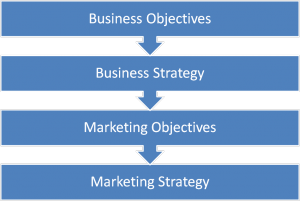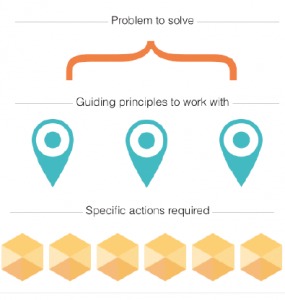Social media marketing is usually viewed as a tactic to drive traffic to a corporate website, but in my experience, its much, much more than that. It is about building a community of people that are passionate about your brand, and who will actively participate in the conversation about that brand, thus helping to form the “narrative” (in PR speak) about the product and services being discussed. If you’re lucky, you’ll even identify a few ‘ambassadors’ or ‘influencers’.
These individuals will will be your most vocal supporters and will speak up to defend the brand in times of crisis. They will also help address concerns from fellow community members on a daily basis. If your brand can get to this stage, where the community is talking about you consistently, and are helping each other without your input, then that’s the clearest sign that your social media plan has succeeded.
A good social media plan has six core steps. Each step on its own won’t deliver much of an impact, but if the whole framework is done correctly, it can in my experience, lead to a thriving, happy and self-sustaining community.
[aesop_image imgwidth=”100%” img=”http://nazeem.me/wp-content/uploads/2015/07/social.png” alt=”social media framework” align=”center” lightbox=”off” captionposition=”left”]
1.) Listening
This is usually a technology tool that allows you to track specific keywords across multiple social media channels. You start by creating a list of keywords based on products, services, competitors and languages. You input these keywords into the tool, and it will start pulling ‘mentions’ with these keywords into a dashboard. The dash board will then display metrics like volume, sentiment and buzz, but it a raw format. Your job will be to ‘cleanse’ this raw data, so that the analysis you do in the next step will be accurate. This cleansing usually means going through a portion of the raw data (20% is a good target), to verify that the automatic grading (relevance, sentiment and influence mostly) are correct, as these would in most cases be assigned by an AI.
Some examples of social listening technology are Sysomos, Radian6, Brandtology and Digimind. These are just a few that I’ve used, and I know that there are dozens more out there.
2.) Analysis
This part quite manual, and its a good idea to have a set process in place to deal with the number crunching that will hopefully deliver some actionable insights. You can do things like word clouds, influence analysis, and trend identification to help you generate insights about your customers, the competition (especially useful when presenting to management), your products and opportunities. These insights are what you use to create a recommendation list that you would use in the day-to-day community management as well as the long term content development.
For analysis, you can use the aforementioned listening tools to do some of the work, but Excel will always be your best friend.
3.) Content
You have a choice: to do it in-house or delegate it to an agency. Either way, the content strategy should address the problems or issues identified in the previous step. Brief the team working on it, and include the insights so that they know what they need to address. Also consider seasonal events for a more holistic view, all of which then go into a central editorial calendar. This should be managed consistently, and updated as soon as new content becomes available.
You can build the calendar in whatever format you prefer. Some publishing (social management) tools have calendars built in, so that’s an option too, as its provides a smooth transition to the next step.
4.) Publishing
Another step that’s best done through a tool, especially if managing multiple social properties and there’s a geographically dispersed team. This tool will allow you to:
- schedule content to be published (posts)
- specify how that content gets posted (targeted vs broad)
- approval workflows
- blacklisting functions (for risk remediation)
- tracking
Some good examples of such tools are Sprinklr, Hootsuite, Buffer (what I use for my own social channels) and SproutSocial.
5.) Conversations
Using the same tool as step 4, this is where the main magic happens. There should be a community manager who does the initial triage based on predetermined rules of engagement. The best example I’ve seen is this one from David Armano:
[aesop_image imgwidth=”100%” img=”http://nazeem.me/wp-content/uploads/2015/07/5042953763_6ab5114e9b_z.jpg” alt=”social media framework” align=”center” lightbox=”off” caption=”David Armano – Social Engagement” captionposition=”left”]
The tool should have built in workflow to enable the community manager to ‘send’ the case (if required) to the relevant authority for resolution. This can be someone in customer service, or marketing, or even sales.
Community management is an art. There are canned responses, but you will be found out quickly by the community, and it will appear unauthentic and forced. You want a real person to respond through your social channels, not a robot. A real person can tell the difference between sarcasm and a real need for help. This will be a human-only job, until the Turing test gets beaten. If that happens, we’ll have a lot more to worry about than social media!
Its not all rosy though. The community manager will be exposed to the vilest humans on the planet, but you will need to be able to filter that out and focus on helping people. A little bit of altruism wouldn’t hurt, for someone in this position. Humor is also crucial. And above all else, patience!
6.) Reporting
The most mundane of processes, but probably the most crucial, as without sharing the results of the preceding 5 steps to management, they probably won’t give you the budget to do any of it! Usually start by looking back (the listening data), what are the current topics being discussed, and what issues will be addressed next. Its also a good idea to tie this back to ROI, so if your tracking has been set up correctly, you should be able to show how much social traffic led to leads and then on to sales.
I usually dump this into a PowerPoint and send it on to the powers that be.
So, that’s it. My 1,000 word guide to getting a social media plan in motion. This approach is 100% organic, and doesn’t take into account paid social. I’ll address that in a further post. Follow these steps, and you should find yourself being the closest link between the company and its customers – and that’s always a great place to be! Let me know in the comments if you think there is anything I’ve missed.
Peace out!



